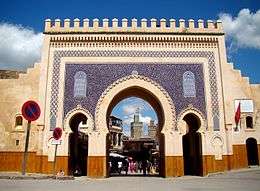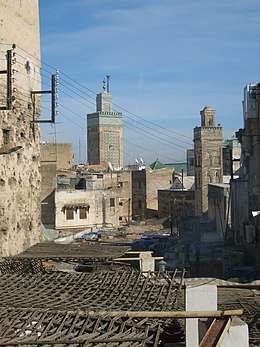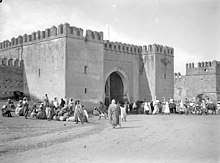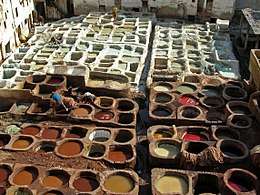Fes el Bali
Fes el Bali (Arabic: فاس البالي) (English: Old Fez) is the oldest walled part of Fez, Morocco. Fes el Bali was founded as the capital of the Idrisid dynasty between 789 and 808 AD.[1] Besides being famous for having the oldest existing, continually operating university in the world, the University of Al-Karaouine, Fes el Bali, with a total population of 156,000, is also believed to be the biggest car-free urban area in the world.[2]
| UNESCO World Heritage Site | |
|---|---|
 The Bab Bou Jeloud gate, leading into the old medina of Fez | |
| Location | Fez, Morocco |
| Part of | Medina of Fez |
| Criteria | Cultural: (ii)(v) |
| Reference | 170-001 |
| Inscription | 1981 (5th session) |
| Area | 220 ha (540 acres) |
| Coordinates | 34°3′40″N 4°58′40″W |
 Location of Fes el Bali in Morocco | |
UNESCO listed Fes el Bali, along with Fes Jdid, as a World Heritage Site in 1981 under the name Medina of Fez. The World Heritage Site includes Fes el Bali's urban fabric and walls as well as a buffer zone outside of the walls that is intended to preserve the visual integrity of the location.[3]
Fes el Bali is, along with Fes Jdid and the French-created Ville Nouvelle or “New Town”, one of the three main districts in Fez.
History


As the capital for his newly acquired empire, Idris ibn Abdallah chose to build a new town on the right bank of the Fez River in 789 CE. Many of the first inhabitants were refugees fleeing from an uprising in Cordoba (modern-day Spain) [4] However, in 809 CE his son, Idris II, decided to found a capital of his own on the opposite bank of the Fez River. Even though they were only separated by a relatively small river the cities developed separately and became two individual cities until they were unified in the 11th century by the Almoravids. There were many refugees who decided to settle in the new city this time too, however this time they fled from an uprising in Kairouan (in modern Tunisia).[4] One good example of how the refugees contributed to making Fez flourish during the early years is the University of Al-Karaouine (or al-Qarawiyyin) that was built by a Tunisian refugee in 859 CE. It is considered the oldest university in the world.[1]
Under the Almoravids, Fez lost its status as a capital when the Almoravids created Marrakech, which they made their capital. The Almoravids destroyed large parts of Fes el Bali but managed to create modern-day Fes el Bali when they united the twin cities by tearing down that separated them and by building bridges across the Fez river.
During Almohad rule, Fez was a thriving merchant city, even though it was not a capital, and even became the largest city in the world during that time, with approximately 200,000 people living there.[5]
After defeating the Almohads in Morocco, the Marinids moved the capital from Marrakech back to Fez.[6] This marked the beginning of the greatest period of the history for Fes el Bali.[6] When the Marinids moved the capital to Fez in 1276 they started building a new town outside the old city walls. At first it was called the white city,[6] but after a while it got a new name: Fes Jdid, or New Fez. This is when Fes el Bali, or the old Fez, got its name too. In the 14th century a mellah was added to the urban fabric.
Threats
According to the UNESCO there are two main threats to this World Heritage Site:
- An ever-increasing population in an already dangerously overpopulated area and the uncontrolled urban development which is a result of that.[1]
- The deterioration of the buildings [1]
Because of the vulnerability of the site the State has adopted a special plan to care for this world heritage site and every building and monument it contains.[1] The aim is to prevent houses from collapsing, increase sustainable tourism and to safeguard everything.
Landmarks
.jpg)
The following are some of the major historic monuments and landmarks in Fes el-Bali.[7][8][9]


Mosques and zawiyas
Madrasas
Palaces, houses and funduqs (traditional inns)
- Dar Batha (Batha Museum)
- Dar Mnebhi
- Funduq al-Najjariyyin (Nejjarine Museum of Wooden Arts and Crafts)
Gates and fortifications
- Historic city walls
- Bab Bou Jeloud (gate)
- Bab Mahrouk (gate)
- Bab Ftouh (gate)
- Bab Guissa (gate)
- Borj Nord (fort; also Museum of Arms)
- Borj Sud (fort)
- Kasbah an-Nouar (walled district) and Bab Chorfa (gate)
Other landmarks and historic sites
- Chouara Tannery
- Marinid Tombs
- Bab Ftouh (cemetery)
- Tala'a Kebira (street)
References
- Centre, UNESCO World Heritage. "Medina of Fez". whc.unesco.org.
- "7 car-free cities".
- Centre, UNESCO World Heritage. "Medina of Fez". whc.unesco.org.
- "History of Fes". www.macalester.edu.
- https://books.google.com/books?id=hEvCpNW2qBwC&pg=PA252 Morocco 2009 (p.252)
- "Fes, Morocco, Time Line of Morocco History, Morocco Weather Information; Latitude 34 North - Cities". www.lat34north.com. Archived from the original on 2018-08-30. Retrieved 2011-01-18.
- Touri, Abdelaziz; Benaboud, Mhammad; Boujibar El-Khatib, Naïma; Lakhdar, Kamal; Mezzine, Mohamed (2010). Le Maroc andalou : à la découverte d'un art de vivre (2 ed.). Ministère des Affaires Culturelles du Royaume du Maroc & Museum With No Frontiers. ISBN 978-3902782311.
- Parker, Richard (1981). A practical guide to Islamic Monuments in Morocco. Charlottesville, VA: The Baraka Press.
- Métalsi, Mohamed (2003). Fès: La ville essentielle. Paris: ACR Édition Internationale. ISBN 978-2867701528.